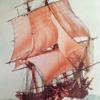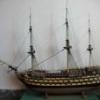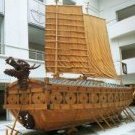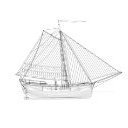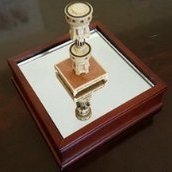HOLIDAY DONATION DRIVE - SUPPORT MSW - DO YOUR PART TO KEEP THIS GREAT FORUM GOING! (89 donations so far out of 49,000 members - C'mon guys!)
×
-
Posts
2,867 -
Joined
-
Last visited
Reputation Activity
-

-
 AON reacted to garyshipwright in HMS ANSON 1781 by albert - 1/48 - 64 guns
AON reacted to garyshipwright in HMS ANSON 1781 by albert - 1/48 - 64 guns
Albert as druxey said both hulls are beautiful examples of framing. You are one heck of a speed builder and I really enjoy seeing you build them so quick. Takes me forever just to build just one frame. Keep up the great build's. Gary
-
 AON got a reaction from Mike Y in HMS Bellerophon 1786 by AON – scale 1:64 – 74-gun 3rd Rate Man of War - Arrogant-Class
AON got a reaction from Mike Y in HMS Bellerophon 1786 by AON – scale 1:64 – 74-gun 3rd Rate Man of War - Arrogant-Class
Hope everyone had a Merry Christmas and Happy New Year!
some update pics
The Taffrail has been drilled and pinned to the stern, and the counter timbers have been cut back to a proper termination level.
The Griffon/Gryphon carvings are coming along but at such a small scale I wonder if I just need more practice or should I use a different wood — Castello versus boxwood basswood (Linden), as I've already lost a hind foot!
I tried using rotary cutters but reverted to mini chisels.
We'll have to wait and see how the head turns out!
🤔
-
 AON reacted to Some Idea in Le Rochefort by Some Idea - 1/24th Scale - First POF Build
AON reacted to Some Idea in Le Rochefort by Some Idea - 1/24th Scale - First POF Build
Funnily enough I wasn't sure about whether I would make all of the parts or not as some parts are so readily available on line. I didn't make the bricks in the stove but the more I build the more important it is that I do make as many parts as possible. I'm sure that many other builders feel the same as the satisfaction is just so nice when the part you make just fits the ship.
-
 AON reacted to Kevin Kenny in HMS Thorn by Kevin Kenny - 1:48 scale - Swan-class - David Antscherl practium
AON reacted to Kevin Kenny in HMS Thorn by Kevin Kenny - 1:48 scale - Swan-class - David Antscherl practium
Hi Alberti
It was a long time ago since i purchased the plans so i have reached out to Micheal and asked him to comment. Here is what is written on the offer.
”SeaWatch has teamed up with David Antscherl and Greg Herbert to continue to help you on your Swan journey and we are delighted to offer the plans for the Swan class sloop featured in David and Greg's four-part series Fully Framed Ship Model.
The plans have been drawn up expressly for model makers who wish to build a fully framed model. Drawn to the classic scale of 1:48, each set consists of two plan sheets. The first includes the sheer and profile, half-breadth and body plan. The second sheet includes all the masts, spars, etc. required for a Swan class vessel or similar ship rigged model of that period. The 35 patterns for the floors, futtocks, toptimbers, hawse timbers and transoms will be included as digital downloads for those who buy the plans. This will enable the builder to print out as many frame patterns as needed to construct each frame.’
So that means to me that you will get all the digital files needed to allow you to make up all the frames, but Michael will respond more directly. When i purchase the plans we got a paper copy of the frame plans. I would have preferred a digital copy.
-
 AON got a reaction from fake johnbull in HMS Bellerophon 1786 by AON – scale 1:64 – 74-gun 3rd Rate Man of War - Arrogant-Class
AON got a reaction from fake johnbull in HMS Bellerophon 1786 by AON – scale 1:64 – 74-gun 3rd Rate Man of War - Arrogant-Class
Hope everyone had a Merry Christmas and Happy New Year!
some update pics
The Taffrail has been drilled and pinned to the stern, and the counter timbers have been cut back to a proper termination level.
The Griffon/Gryphon carvings are coming along but at such a small scale I wonder if I just need more practice or should I use a different wood — Castello versus boxwood basswood (Linden), as I've already lost a hind foot!
I tried using rotary cutters but reverted to mini chisels.
We'll have to wait and see how the head turns out!
🤔
-
 AON reacted to Some Idea in Le Rochefort by Some Idea - 1/24th Scale - First POF Build
AON reacted to Some Idea in Le Rochefort by Some Idea - 1/24th Scale - First POF Build
Starting on the catheads I could see that they both have a cleat on the top of them and there are 6 others across the gunwale. So I thought let's start with them as I've never made cleats before and I can make them all in one go. For some reason I thought it would be good to make them out of brass and blacken them as in my mind they will make a nice contrast to the wood.
So without knowing what I'm doing I started with a piece of flat brass bar which was 3 times thicker than required at 6mm. I used this piece simply because I'm still waiting on a chuck for the tail stock so I couldn't centre drill a hole for the live centre. I needed some strength in the material due to the amount of metal sticking out of the chuck.
So once again I used an independent 4 jaw chuck to hold the brass and using the drawings I roughed out 8 cleats leaving plenty of material between each one.
I then placed this on the mill and cut the piece down to its correct width of 2mm. The rough finish is because I held it down on the tooling plate with double sided tape. I also thinned the bottom of each cleat to make the separation from their tops.
Next was to cut the familiar curved top edge and then cut the cleat off using a hacksaw. Then I could finish the basic shape by hand using a file.
After that was done I drilled 2 - 0.5mm holes in each cleat and put some 0.5mm brass rod through. This acts as both the fixing heads and location dowels onto the ship. The rods were fixed in place using a small drop of Loctite 271 rather than soldering.
Finally I rounded everything off as best I could and chemically blackened them. I fitted the 4 cleats onto the bow gunwale and 2 onto the stern as per the drawings. This leaves me 2 left for the catheads. All in all I'm pretty pleased the way these have turned out as I made up the cutting sequences on the go.
I would like to thank everyone for the advice, corrections, encouragement and the downright lovely comments.
Catheads next
Cheers Mark
-
 AON got a reaction from gjdale in HMS Bellerophon 1786 by AON – scale 1:64 – 74-gun 3rd Rate Man of War - Arrogant-Class
AON got a reaction from gjdale in HMS Bellerophon 1786 by AON – scale 1:64 – 74-gun 3rd Rate Man of War - Arrogant-Class
Hope everyone had a Merry Christmas and Happy New Year!
some update pics
The Taffrail has been drilled and pinned to the stern, and the counter timbers have been cut back to a proper termination level.
The Griffon/Gryphon carvings are coming along but at such a small scale I wonder if I just need more practice or should I use a different wood — Castello versus boxwood basswood (Linden), as I've already lost a hind foot!
I tried using rotary cutters but reverted to mini chisels.
We'll have to wait and see how the head turns out!
🤔
-
 AON got a reaction from gjdale in HMS Bellerophon 1786 by AON – scale 1:64 – 74-gun 3rd Rate Man of War - Arrogant-Class
AON got a reaction from gjdale in HMS Bellerophon 1786 by AON – scale 1:64 – 74-gun 3rd Rate Man of War - Arrogant-Class
Well, I managed one of the two upper cheek finishing bits. It is presently soaking to be removed from the baseboard.
I also installed the trail boards and decided on the figure, a griffon or gryphon if you prefer. The drawing has been mounted to some bass wood (linden) and that glued to a baseboard in readiness for carving.
As I am getting tired of looking at my mistake at the stern, I've cut out the transom taffrail board in black walnut, steamed it, and it is presently clamped and drying. The clamp piece is a scrap 2x4 piece of lumber cut to the curve of the present stern taken with my profile gauge. I will not unclamp it until after Christmas. I intend to remove the offending counter timber tops sometime soon (in the new year) and will replace them with the taffrail board.
-
 AON got a reaction from Rock_From_Korea in HMS Bellerophon 1786 by AON – scale 1:64 – 74-gun 3rd Rate Man of War - Arrogant-Class
AON got a reaction from Rock_From_Korea in HMS Bellerophon 1786 by AON – scale 1:64 – 74-gun 3rd Rate Man of War - Arrogant-Class
Hope everyone had a Merry Christmas and Happy New Year!
some update pics
The Taffrail has been drilled and pinned to the stern, and the counter timbers have been cut back to a proper termination level.
The Griffon/Gryphon carvings are coming along but at such a small scale I wonder if I just need more practice or should I use a different wood — Castello versus boxwood basswood (Linden), as I've already lost a hind foot!
I tried using rotary cutters but reverted to mini chisels.
We'll have to wait and see how the head turns out!
🤔
-
 AON reacted to druxey in HMS Bellerophon 1786 by AON – scale 1:64 – 74-gun 3rd Rate Man of War - Arrogant-Class
AON reacted to druxey in HMS Bellerophon 1786 by AON – scale 1:64 – 74-gun 3rd Rate Man of War - Arrogant-Class
Ah; chip happens!
-
 AON reacted to Dowmer in HMS Bellerophon 1786 by AON – scale 1:64 – 74-gun 3rd Rate Man of War - Arrogant-Class
AON reacted to Dowmer in HMS Bellerophon 1786 by AON – scale 1:64 – 74-gun 3rd Rate Man of War - Arrogant-Class
Alan, if the carving details continue to give you issues, I’d strongly advise switching to a better carving wood such as boxwood or some other hardwood with a fine solid grain. Bass wood/Lime wood/Linden is fairly fiberous and soft and has a difficulty holding fine smooth details at your scale.
great progress btw and enjoying your journey.
-
 AON got a reaction from Cpt.Barbossa in HMS Bellerophon 1786 by AON – scale 1:64 – 74-gun 3rd Rate Man of War - Arrogant-Class
AON got a reaction from Cpt.Barbossa in HMS Bellerophon 1786 by AON – scale 1:64 – 74-gun 3rd Rate Man of War - Arrogant-Class
Hope everyone had a Merry Christmas and Happy New Year!
some update pics
The Taffrail has been drilled and pinned to the stern, and the counter timbers have been cut back to a proper termination level.
The Griffon/Gryphon carvings are coming along but at such a small scale I wonder if I just need more practice or should I use a different wood — Castello versus boxwood basswood (Linden), as I've already lost a hind foot!
I tried using rotary cutters but reverted to mini chisels.
We'll have to wait and see how the head turns out!
🤔
-
 AON got a reaction from Wintergreen in HMS Bellerophon 1786 by AON – scale 1:64 – 74-gun 3rd Rate Man of War - Arrogant-Class
AON got a reaction from Wintergreen in HMS Bellerophon 1786 by AON – scale 1:64 – 74-gun 3rd Rate Man of War - Arrogant-Class
Hope everyone had a Merry Christmas and Happy New Year!
some update pics
The Taffrail has been drilled and pinned to the stern, and the counter timbers have been cut back to a proper termination level.
The Griffon/Gryphon carvings are coming along but at such a small scale I wonder if I just need more practice or should I use a different wood — Castello versus boxwood basswood (Linden), as I've already lost a hind foot!
I tried using rotary cutters but reverted to mini chisels.
We'll have to wait and see how the head turns out!
🤔
-
 AON got a reaction from albert in HMS Bellerophon 1786 by AON – scale 1:64 – 74-gun 3rd Rate Man of War - Arrogant-Class
AON got a reaction from albert in HMS Bellerophon 1786 by AON – scale 1:64 – 74-gun 3rd Rate Man of War - Arrogant-Class
Hope everyone had a Merry Christmas and Happy New Year!
some update pics
The Taffrail has been drilled and pinned to the stern, and the counter timbers have been cut back to a proper termination level.
The Griffon/Gryphon carvings are coming along but at such a small scale I wonder if I just need more practice or should I use a different wood — Castello versus boxwood basswood (Linden), as I've already lost a hind foot!
I tried using rotary cutters but reverted to mini chisels.
We'll have to wait and see how the head turns out!
🤔
-
 AON got a reaction from druxey in HMS Bellerophon 1786 by AON – scale 1:64 – 74-gun 3rd Rate Man of War - Arrogant-Class
AON got a reaction from druxey in HMS Bellerophon 1786 by AON – scale 1:64 – 74-gun 3rd Rate Man of War - Arrogant-Class
Jared... something to think about but as you know David Antscherl is a member of the club and is much better at it then I might ever be!
Druxey... I had a brain fart and typed boxwood instead of basswood. I've corrected the post. Thanks for catching that.
My chisels are quite sharp. It was likely a flaw in the wood. I suspect I will add the foot to the piece separately. If I do it well no one should notice.
-
 AON got a reaction from chris watton in HMS Bellerophon 1786 by AON – scale 1:64 – 74-gun 3rd Rate Man of War - Arrogant-Class
AON got a reaction from chris watton in HMS Bellerophon 1786 by AON – scale 1:64 – 74-gun 3rd Rate Man of War - Arrogant-Class
Hope everyone had a Merry Christmas and Happy New Year!
some update pics
The Taffrail has been drilled and pinned to the stern, and the counter timbers have been cut back to a proper termination level.
The Griffon/Gryphon carvings are coming along but at such a small scale I wonder if I just need more practice or should I use a different wood — Castello versus boxwood basswood (Linden), as I've already lost a hind foot!
I tried using rotary cutters but reverted to mini chisels.
We'll have to wait and see how the head turns out!
🤔
-
 AON got a reaction from Some Idea in HMS Bellerophon 1786 by AON – scale 1:64 – 74-gun 3rd Rate Man of War - Arrogant-Class
AON got a reaction from Some Idea in HMS Bellerophon 1786 by AON – scale 1:64 – 74-gun 3rd Rate Man of War - Arrogant-Class
Hope everyone had a Merry Christmas and Happy New Year!
some update pics
The Taffrail has been drilled and pinned to the stern, and the counter timbers have been cut back to a proper termination level.
The Griffon/Gryphon carvings are coming along but at such a small scale I wonder if I just need more practice or should I use a different wood — Castello versus boxwood basswood (Linden), as I've already lost a hind foot!
I tried using rotary cutters but reverted to mini chisels.
We'll have to wait and see how the head turns out!
🤔
-
 AON got a reaction from Some Idea in HMS Bellerophon 1786 by AON – scale 1:64 – 74-gun 3rd Rate Man of War - Arrogant-Class
AON got a reaction from Some Idea in HMS Bellerophon 1786 by AON – scale 1:64 – 74-gun 3rd Rate Man of War - Arrogant-Class
Well, I managed one of the two upper cheek finishing bits. It is presently soaking to be removed from the baseboard.
I also installed the trail boards and decided on the figure, a griffon or gryphon if you prefer. The drawing has been mounted to some bass wood (linden) and that glued to a baseboard in readiness for carving.
As I am getting tired of looking at my mistake at the stern, I've cut out the transom taffrail board in black walnut, steamed it, and it is presently clamped and drying. The clamp piece is a scrap 2x4 piece of lumber cut to the curve of the present stern taken with my profile gauge. I will not unclamp it until after Christmas. I intend to remove the offending counter timber tops sometime soon (in the new year) and will replace them with the taffrail board.
-
 AON got a reaction from Some Idea in HMS Bellerophon 1786 by AON – scale 1:64 – 74-gun 3rd Rate Man of War - Arrogant-Class
AON got a reaction from Some Idea in HMS Bellerophon 1786 by AON – scale 1:64 – 74-gun 3rd Rate Man of War - Arrogant-Class
I had been working on the lower cheeks and have since started the upper cheeks.
I began by making a card template of the hull using my profile gauge.
Then I traced the stem works to fit the upper cheek between the gammoning slots.
The lower cheek was made in two pieces, glued and pinned with wooden dowels requiring #57 drill bit holes.
The upper cheek will be in three pieces of which I have two pieces roughed. The piece against the stem works is longer than needed. I will make the mating piece longer and trim the two to fit.
Tomorrow I will make up the hawse bolster and backing plate pieces to help with spacing and alignment of the upper cheek pieces.
-
 AON got a reaction from druxey in HMS Bellerophon 1786 by AON – scale 1:64 – 74-gun 3rd Rate Man of War - Arrogant-Class
AON got a reaction from druxey in HMS Bellerophon 1786 by AON – scale 1:64 – 74-gun 3rd Rate Man of War - Arrogant-Class
Hope everyone had a Merry Christmas and Happy New Year!
some update pics
The Taffrail has been drilled and pinned to the stern, and the counter timbers have been cut back to a proper termination level.
The Griffon/Gryphon carvings are coming along but at such a small scale I wonder if I just need more practice or should I use a different wood — Castello versus boxwood basswood (Linden), as I've already lost a hind foot!
I tried using rotary cutters but reverted to mini chisels.
We'll have to wait and see how the head turns out!
🤔
-
 AON reacted to Some Idea in Le Rochefort by Some Idea - 1/24th Scale - First POF Build
AON reacted to Some Idea in Le Rochefort by Some Idea - 1/24th Scale - First POF Build
Some more work done and this time it's the main mast and chocks. I'm not rigging this ship so the mast is just going to be a stubby.
Sorry this post is going to be a bit picture heavy so firstly the main mast. I didn't have timber with a big enough dimension to make the 16mm diameter mast. So I glued 4 equal pieces together which I ran through a thickness sander to get a good flat gluing surface. This piece was then placed in an independent 4 jaw chuck and supported by a live centre.
This was then turned to the required diameter - this was easy with wood but I don't think I'd try a length of metal like this without support.
Next was to cut it to length; make the iron band to prevent the base of the mast from splitting and also shape the base to sit in the mast step.
The mast partner also required finishing and I wanted to make a nice feature of this. I had the problem of cutting 10 pieces at exactly 36 degrees and I just don't have the equipment to cut such long pieces accurately. So I decided to make it out of 30 individually cut pieces all glued together and then use a glued in dowel to be able to mount it in a chuck.
Next I turned the inner and outer dimensions and once this was done sanded the end faces to 7 degrees to match the final angle of the mast.
The piece in place on the main deck
Then I made the mast step chocks - the one on the left is also cut at an angle to match the mast.
Finally all of the pieces are assembled and fixed into the hull.
I think my next job is going to be the catheads but I'm not sure yet
Cheers Mark
-
 AON got a reaction from Nirvana in Miss Adventure by Andrewiscookin - FINISHED - Model Shipways - 1:6 - RADIO
AON got a reaction from Nirvana in Miss Adventure by Andrewiscookin - FINISHED - Model Shipways - 1:6 - RADIO
Or the seal to the prop shaft is dry and tight?
-
 AON reacted to Some Idea in Le Rochefort by Some Idea - 1/24th Scale - First POF Build
AON reacted to Some Idea in Le Rochefort by Some Idea - 1/24th Scale - First POF Build
Ah ha now I understand 🙂. Thanks druxey I can see exactly what you mean now and why. This is an easy fix too - much appreciated
-
 AON reacted to druxey in Le Rochefort by Some Idea - 1/24th Scale - First POF Build
AON reacted to druxey in Le Rochefort by Some Idea - 1/24th Scale - First POF Build
The positions of the cleats look fine, it's just that the fore faces as you move away from top center will dig into the rope and fray it in time. As an example, your rule only touches the upper corner of the nearest cleat in the photo. It should touch all the way across its face as seen in the partial plan. If you are still unsure of what I mean, take a turn of string around the bowsprit as a quasi line.
The photo (although a different subject) shows rows of these cleats with varying fore angles to their faces. Hope this helps!



